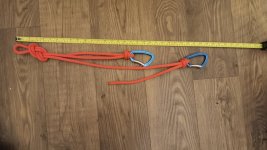As for the long cowstail, most people tie it nice and long to give plenty of flexibility to move when it's clipped in but not so long that if you fall, you can't reach whatever you're clipped into, to pull yourself back up. I wonder if there's a maximum length we should go to though, particularly for taller people. If you do fall, the longer the cowstail is means you'll fall for a longer time, before being stopped by the cowstail. This means that you will be accelerating for longer and will therefore achieve a greater speed and higher loads when you do come to a stop. At what point does this become dangerous?
I remember doing an after work bridge jump with Simon Nadin off the Menai Bridge on a couple of 50m low stretch ropes in the mid 80's. We both had very big rope loops dangling below us into the darkness. It was the biggest loop I had ever jumped with, and I did a lot of bridge jumping in those days. I can tell you some interesting stories!!
When we first climbed over the railings we were surprised to see about 10 people on the gantry all planning on jumping at the same time, but from opposite sides, about 5m apart!! I still can't believe we got away with it!
We fell a long way before the ropes tightened and took us into a big, fast, pendulum swing and up the other side. You go a lot higher on low stretch ropes, and get a second dynamic jolt on the way back down. I don't ever remember the forces being particularly uncomfortable. We went back for more on another, much narrower and taller bridge we had a railway line closure for the following day. We were prepared for it though, with our hands already holding the ropes ready for when they went tight, which helped us keep more upright, and we did use climbing harnesses with a slightly higher attachment point to a caving harness. You would naturally try grasping for the cow's tail rope in an accidental fall, as would probably be the case in a cave situation..
After the Menai Bridge jump with Simon, Chris Rhodes and I talked him, over a few pints, into taking the following week off work to practice for the British Indoor Climbing Championships in Leeds. He originally hated the idea of climbing competitions but someone had put his name forward. He took our advice, won the British Championships and then went on to win the World Championships.
I suppose it becomes dangerous at the point when falling a further distance could result in you hitting something on the way down that could cause a much more serious injury than any impact force from a fall onto a cow's tail is ever likely to give you, like bashing your head against a wall and being suspended, unconscious, in an upside down banana position with a blocked windpipe!! ABC, oh and that suspension trauma / syncope / intolerance thingy. Just ABC for me please.
The forces of gravity in industry are the same as down a cave, and in industry the aim is to always reduce, so far as is reasonably practicable, the distance and consequences of a fall.
Got some rope cowstails from Inglesport and was just retying them onto my crabs then got to thinking is there a best practice for the length of the two legs? Appreciate it's not a one size fits all job
How did you get on with your previous cows'tail lengths?
I made my first cow's tails as long as an experienced member of my club suggested. I made a few adjustments over a few trips, particularly one down Juniper Gulf, and I just make any new ones the exact same lengths as the last set. I don't even know what the leg measurements are.




